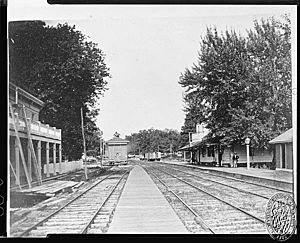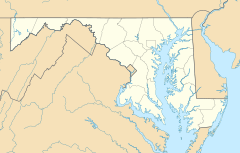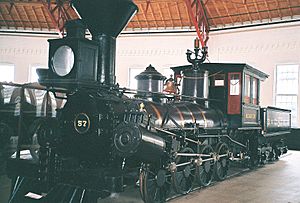Annapolis Junction, Maryland facts for kids
Quick facts for kids
Annapolis Junction, Maryland
|
|
|---|---|
 |
|
| Country | United States of America |
| State | Maryland |
| Counties | Anne Arundel, Howard |
| Time zone | UTC−5 (Eastern (EST)) |
| • Summer (DST) | UTC−4 (EDT) |
| Zip code |
20701
|
Annapolis Junction is a small, unincorporated community in Howard and Anne Arundel counties, Maryland, United States. It's a place that has played an important role in history, especially because of its location along major transportation routes. In 2000, only about 40 people lived here.
Contents
A Look Back: The History of Annapolis Junction
Annapolis Junction has a long and interesting past, starting way back in the 1600s.
Early Beginnings
The area around Annapolis Junction was first settled around 1650. A man named Colonel Henry Ridgely, who was a member of Maryland's government, surveyed the land in 1685. He named this area "Ridgely's Forrest."
The Railroad Arrives
Annapolis Junction became a very important spot when the Baltimore and Ohio Railroad (B&O) built its main line through here. In 1840, the Annapolis and Elk Ridge Railroad connected to the B&O line at this point. This made it a "junction" – a place where two train lines met – providing a rail route to Annapolis from big cities like Washington and Baltimore. The Annapolis Junction post office opened on August 26, 1844.
The First Telegraph Message
A very important event happened here on May 1, 1844. The first practical news telegram was sent from Annapolis Junction! It was sent by Alfred Vail to Samuel F. B. Morse, who invented the telegraph. The message shared news about political candidates. When the candidates arrived in Washington by train, the news was already being announced in the city's newspapers, thanks to this new technology.
Annapolis Junction During the Civil War
Because it was located on the B&O Railroad, which was a main route for goods and people, Annapolis Junction saw a lot of activity during the Civil War. It was the only rail line into Washington, D.C.
Lincoln's Secret Journey
In 1861, Abraham Lincoln passed through Annapolis Junction on his way to Washington for his inauguration. He traveled in secret to avoid danger in Baltimore.
A Busy Wartime Spot
During the war, a large hotel called the Howard House operated here, serving travelers and soldiers. Troops often passed through Annapolis Junction. For example, in May 1861, the 7th New York Militia arrived. Soldiers sometimes faced tough conditions, lacking equipment and good food.
The railroad tracks were very important and needed to be guarded. In 1862, troops were assigned to protect the B&O railroad lines around Annapolis Junction. In 1863, Annapolis Junction became a meeting point for men drafted into the army from Maryland.
After the Civil War
After the war, important people continued to pass through Annapolis Junction.
Presidential Visits
In June 1867, President Andrew Johnson met with Maryland Governor Thomas Swann at Annapolis Junction. They discussed important state matters.
A Close Call for President Grant
On June 12, 1869, a train carrying President Ulysses S. Grant, his wife, and others hit a cow near Annapolis Junction. The train went off the tracks, and 30 passengers were hurt, but President Grant and his group were safe.
Post Office Moves
The Annapolis Junction post office moved between Howard County and Anne Arundel County several times over the years. It moved to the Howard County side in 1871, then back to Anne Arundel in 1919, and then back to Howard County in 1921.
World War I and Fort Meade
In June 1917, during World War I, the government decided to buy a large area of land (about 17,000 acres) at Annapolis Junction. This land was used to build a huge training camp for soldiers, which would train 40,000 to 60,000 men. This camp eventually became Fort George G. Meade, a very important military base. After Fort Meade was established, Annapolis Junction was sometimes called "Fort Meade Junction."
Annapolis Junction Today
Today, Annapolis Junction is no longer a railroad junction in the same way it used to be. It has developed into a modern area with a few key features.
- The historic CSX railroad line (which used to be the B&O) still runs north to south.
- Maryland Route 32, a major road, runs east to west.
- There are many office buildings and warehouses to the west.
- To the east, you'll find facilities related to Fort Meade.
While it's a historic place, much of Annapolis Junction is now zoned for industrial use. The National Cryptologic Museum, which is part of the NSA, is often referred to as being in Annapolis Junction.
Many people who live near Annapolis Junction often say they are from nearby communities like Savage, Laurel, or Fort Meade.
Annapolis Junction also has a special facility where Howard County's trash is transferred to trains to be moved to another location.
Modern Transportation Hub
The State of Maryland built a park-and-ride MARC Train commuter station near the original Annapolis Junction station. It's called Savage MARC. In 2014, plans were announced to develop the land around the station into a new area called Annapolis Junction Town Center, which includes a large parking garage and apartments. This area is also next to a bus terminal for the Regional Transportation Agency of Central Maryland.
Economy
Annapolis Junction is home to Colfax Corporation, a large company that makes welding equipment, air and gas handling equipment, and medical devices.
Notable Person
- Stephen Latchford was a United States diplomat who was an expert in aviation laws.




